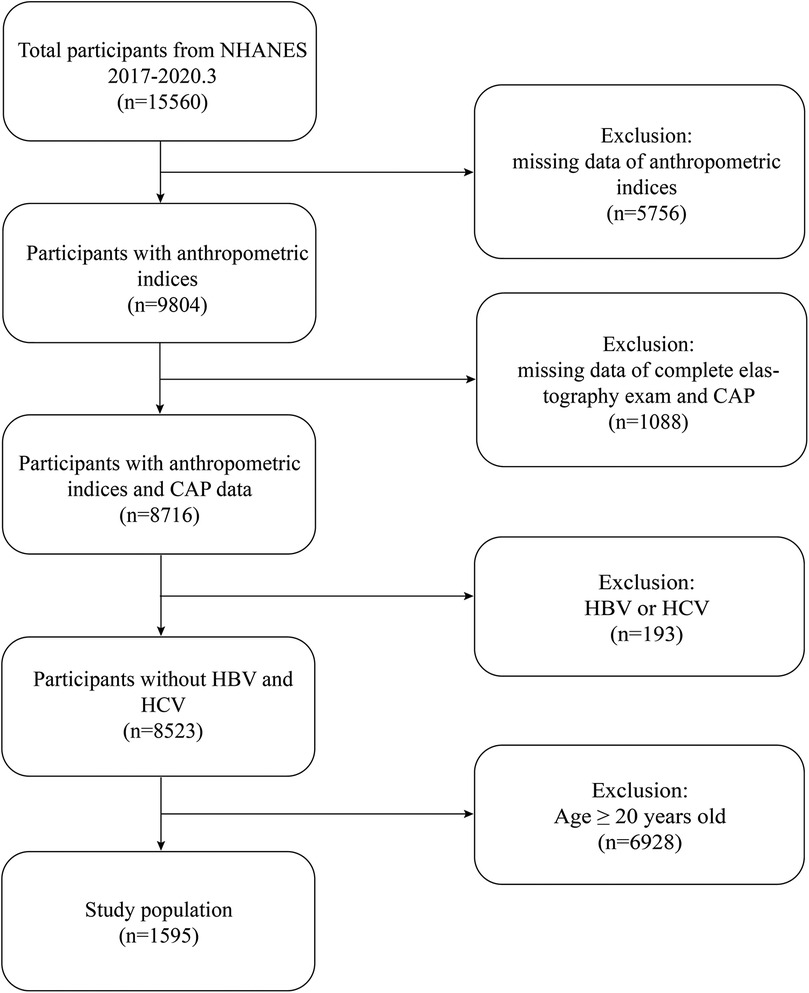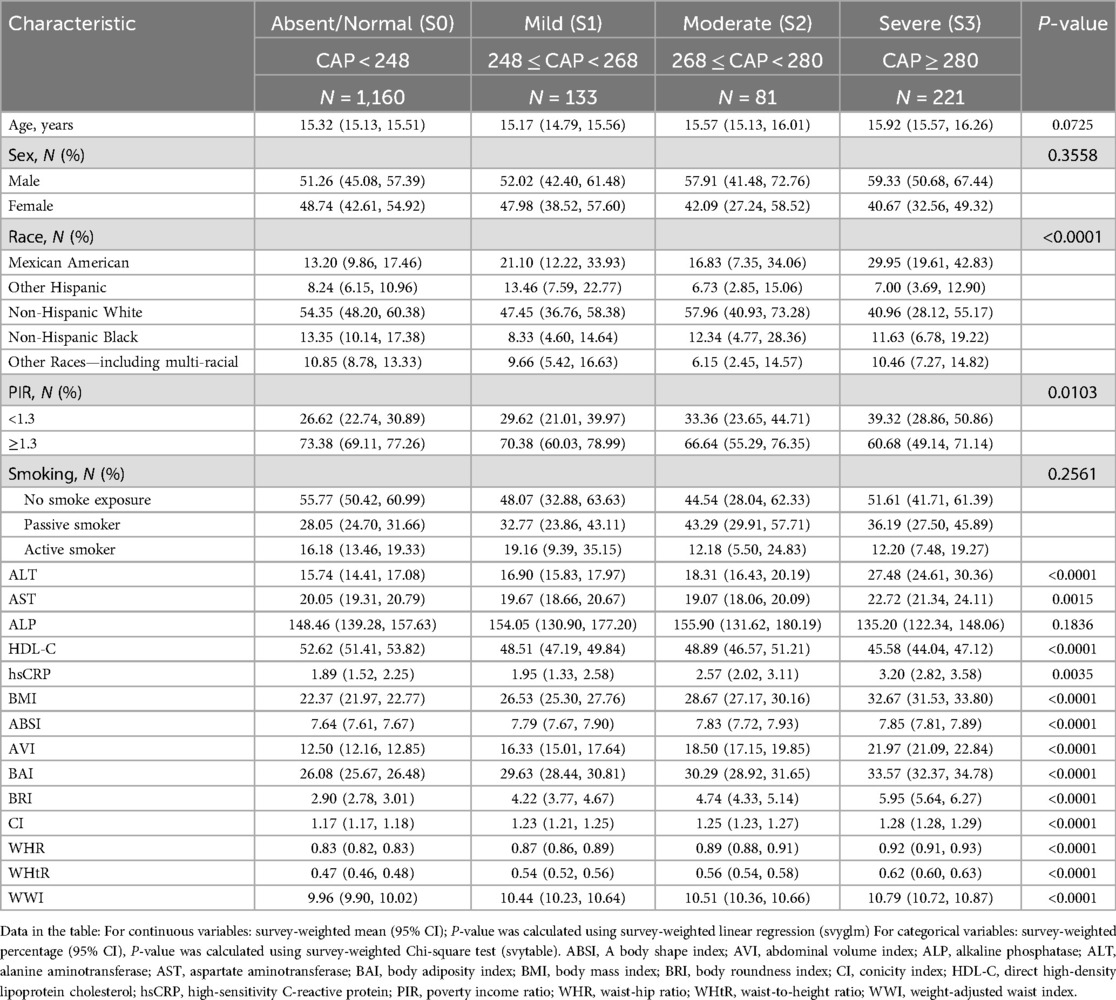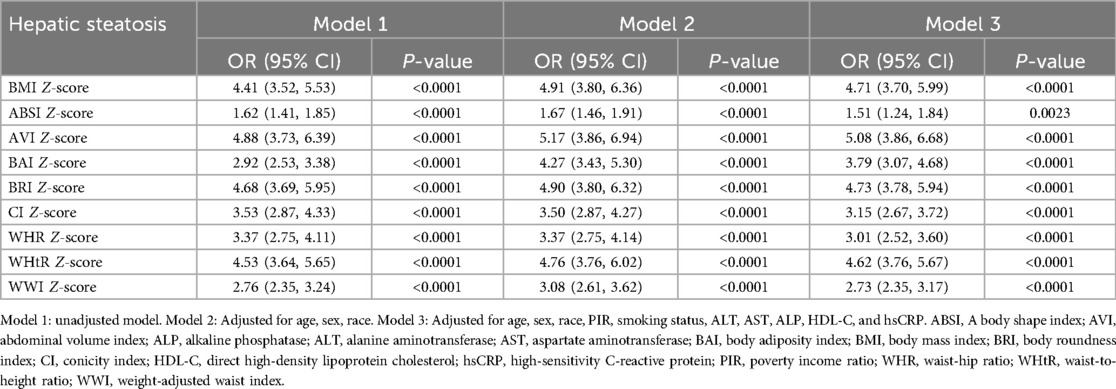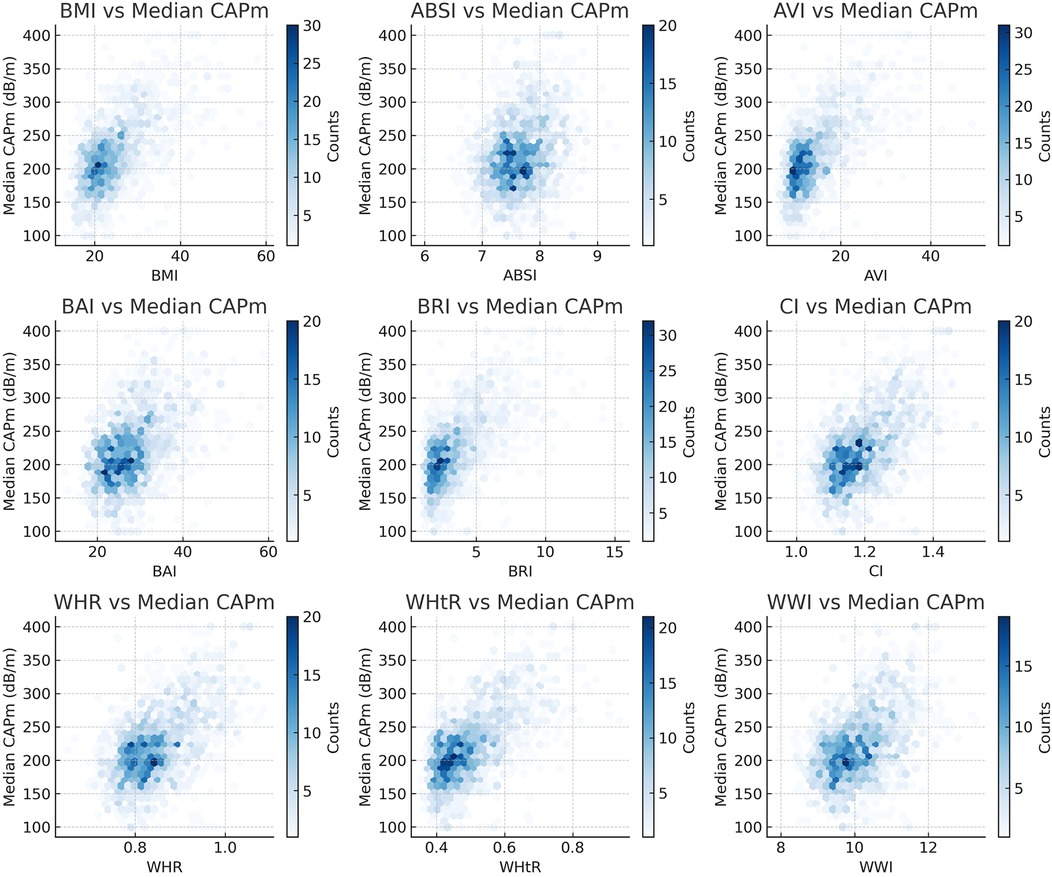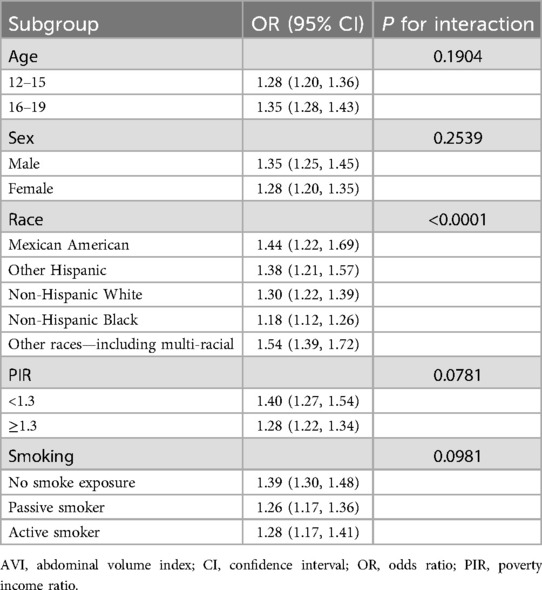- 1School of Medicine, Shaoxing University, Shaoxing, Zhejiang, China
- 2Department of Hepato-Biliary-Pancreatic Surgery, Shaoxing People’s Hospital, Shaoxing, Zhejiang, China
- 3School of Medicine, Zhejiang University, Hangzhou, Zhejiang, China
Purpose: The increasing prevalence of obesity among adolescents has resulted in an increase in the incidence of hepatic steatosis; however, the relationship between anthropometric measurements and this condition in youth remains underexplored.
Aims: To evaluate the effectiveness of nine anthropometric indicators in predicting the risk of hepatic steatosis in adolescents.
Methods: We assessed several anthropometric indicators, including the abdominal volume index (AVI), body mass index, body roundness index, body adiposity index, conicity index, waist-hip ratio, waist-to-height ratio, and weight-adjusted waist index. Statistical methods such as multivariate logistic regression, smooth curve fitting, and subgroup analysis were employed. Discriminative accuracy was determined using receiver operating characteristic curve analysis, and a tool based on the optimal Youden index was developed.
Results: All nine indices were significantly correlated with hepatic steatosis in adolescents. AVI demonstrated the strongest predictive ability, with an area under the curve of 0.8454 (95% confidence interval: 0.8221–0.8687, best threshold: 14.9992). Variations in predictive accuracy were observed across racial and ethnic subgroups, highlighting the importance of demographic factors.
Conclusion: All nine anthropometric indices are associated with hepatic steatosis, with AVI emerging as the most effective tool for assessing liver health in adolescents.
1 Introduction
The rising prevalence of obesity among adolescents has become a critical global public health issue. In the United States, 20.9% of adolescents aged 12–19 are classified as obese (1). This excessive weight not only increases the risk of various health complications but also exacerbates the likelihood of experiencing physical and psychological conditions, such as depression (2), disrupted sleep patterns (3), early onset of puberty (4), high blood pressure (5), and non-alcoholic fatty liver disease (NAFLD) (6). Alarmingly, NAFLD affects 36.1% of obese adolescents (7), underscoring the significance of addressing this liver-related condition, which can progress to more severe health problems if left untreated. Severe hepatic steatosis, commonly referred to as fatty liver, results from the accumulation of excess fat in liver cells. Metabolic syndrome—defined as a cluster of metabolic abnormalities, including central obesity, insulin resistance, dyslipidemia, and hypertension—is closely associated with NAFLD. In pediatric populations, the definition of metabolic syndrome is adjusted for age and developmental stage, but its presence significantly increases the risk of hepatic steatosis and its progression (8). As obesity and NAFLD rates continue to rise among adolescents, the global incidence of hepatic steatosis is also increasing (9). This condition can impair liver function and potentially lead to more severe liver diseases, such as fibrosis, cirrhosis, and even liver cancer, which pose substantial long-term health risks (10). Early detection of hepatic abnormalities in adolescents is crucial, as prompt intervention can slow disease progression and improve long-term health outcomes.
Basic tools such as tape measures and scales allow parents to monitor their children's physical development. Various anthropometric indicators, including body mass index (BMI) (11), weight-adjusted waist index (WWI) (12), and waist-to-height ratio (WHtR) (13), have been associated with hepatic steatosis. These indices are valuable for prevention and diagnostic purposes. These metrics are essential in identifying the risk of hepatic steatosis, enabling early intervention and timely medical diagnosis. However, most research has focused on adults, and studies on adolescents remain limited and inconclusive.
The primary objective of this study is to assess and compare the effectiveness of nine distinct anthropometric indicators in predicting hepatic steatosis among adolescents. These indicators include the body shape index (ABSI), abdominal volume index (AVI), BMI, body roundness index (BRI), body adiposity index (BAI), conicity index (CI), WHtR, waist-hip ratio (WHR), and WWI. Each of these indices offers a unique approach to identifying hepatic steatosis, a condition characterized by abnormal fat accumulation in liver cells. BMI provides a general measure of body fat, ABSI assesses body shape-related health risks, AVI focuses on abdominal fat, BAI estimates adiposity, BRI gauges body roundness, CI evaluates body contour, WHR compares waist to hip size, WHtR relates waist circumference to height, and WWI adjusts waist circumference for weight. This comprehensive approach enhances our ability to detect adolescents at risk of hepatic steatosis. Data for this study were drawn from the NHANES 2017–2020 dataset. Our analysis aims to establish the most effective cutoff values for these indices, thereby refining the risk assessment for hepatic steatosis in adolescents. The results will contribute to the early detection of high-risk individuals, facilitating timely intervention and reducing the incidence of hepatic steatosis, ultimately improving the health outcomes for adolescents.
2 Material and methods
2.1 Study design and participants
Data for this study were obtained from the National Health and Nutrition Examination Survey (NHANES), a comprehensive health assessment conducted by the National Center for Health Statistics (NCHS) under the Centers for Disease Control and Prevention (CDC). The primary objectives of NHANES are to collect and evaluate dietary and health data from across the United States, monitor health trends, and provide scientific evidence to inform public health policies (14).
The study population was drawn from NHANES 2017–2020, focusing on participants aged 12–19 years with complete anthropometric measurements and Controlled Attenuation Parameter (CAP) data. Initially, 15,560 individuals were enrolled. After exclusions due to missing anthropometric data (5,756 participants), non-completion of liver elastography or missing CAP values (1,088 participants), as well as exclusions of individuals aged 20 years or older and those with hepatitis B or C infections (6,928 participants), a final cohort of 1,595 adolescents remained for analysis (Figure 1).
2.2 Definition of anthropometric indices and their measurements
According to the Protocols and Procedures documents available on the CDC's NHANES website, anthropometric measurements were obtained at the Mobile Examination Centers (MEC), where trained professionals followed standardized protocols and used validated instruments to collect data, including height, weight, waist circumference (WC), and hip circumference (HC). The nine anthropometric indices were derived using established formulas, as referenced in previous studies (15–17):
ABSI, A body shape index; AVI, abdominal volume index; BAI, body adiposity index; BMI, body mass index; BRI, body roundness index; CI, conicity index; HC, hip circumference; WC, waist circumference; WHR, waist-hip ratio; WHtR, waist-to-height ratio; WWI, weight-adjusted waist index.
Our study included nine anthropometric indices as exposure variables.
2.3 Hepatic steatosis evaluation
Hepatic steatosis was assessed using FibroScan® technology, a non-invasive method that utilizes ultrasound to quantify liver fat. The result is the controlled attenuation parameter (CAP), a numerical indicator of hepatic steatosis. Hepatic fat infiltration was categorized histologically into four classes: S0 (no or minimal fat, <5% hepatocytes with fat); S1 (mild fat infiltration, 5%–33% hepatocytes with fat); S2 (moderate fat infiltration, 33%–66% hepatocytes with fat); and S3 (severe fat infiltration, >66% hepatocytes with fat) (18). Based on previous studies, CAP values are classified as follows: S0 (CAP < 248 dB/m), S1 (248 ≤ CAP < 268 dB/m), S2 (268 ≤ CAP < 280 dB/m), and S3 (CAP ≥ 280 dB/m) (19). Hepatic steatosis was defined by a CAP value of 248 dB/m or higher.
2.4 Covariates
Several covariates were considered in this study, including age, sex, race, poverty income ratio (PIR), smoking status, and various biochemical markers, such as alanine aminotransferase (ALT), aspartate aminotransferase (AST), alkaline phosphatase (ALP), high-density lipoprotein cholesterol (HDL-C), and high-sensitivity C-reactive protein (hs-CRP). The PIR was used to measure socioeconomic status, with values of PIR < 1.3 indicating economic disadvantage and PIR ≥ 1.3 indicating economic stability (20). Smoking status was categorized based on serum cotinine levels: non-exposed (≤0.05 ng/ml), passive exposure (0.05–2.99 ng/ml), and active exposure (>2.99 ng/ml) (20). Missing data were imputed using a random forest model. Continuous variables included age, ALT, AST, ALP, HDL-C, and hs-CRP, while other variables were categorized. Detailed measurement methodologies are publicly available on the CDC's NHANES website.
2.5 Statistical analysis
Statistical analysis was performed using Python (version 3.10), R software (version 4.2.0), and EmpowerStats (version 6.0), following NHANES protocols for the computation and application of sample weights. Continuous and categorical variables were presented using weighted averages and 95% confidence intervals (CIs). Anthropometric indices were normalized using Z-scores, calculated as .
Multivariate logistic regression analyses were conducted using three models: Model 1 (no adjustments), Model 2 (adjusted for age, sex, and ethnicity), and Model 3 (adjusted for a comprehensive set of covariates). The relationship between anthropometric indices and hepatic steatosis was further explored using smooth curve fitting techniques. The area under the receiver operating characteristic (ROC) curve (AUC) was used to assess the predictive accuracy of each anthropometric index for hepatic steatosis. Stratified multivariate logistic regression models were applied to examine how the association between AVI and hepatic steatosis varied across different demographic subgroups, including age, sex, race, income, and smoking status. The optimal cutoff value for prediction was determined using the Youden index derived from ROC curve analysis. A simple Python program was developed to alert users when their AVI exceeds a specified threshold, indicating an increased risk of hepatic steatosis. Statistical significance was determined for P-values below 0.05.
3 Results
3.1 Demographic and baseline attributes
Table 1 presents the demographic and baseline characteristics of the adolescents in the NHANES cohort, including detailed information on hepatic steatosis and various anthropometric measures.
The analysis involved a total of 1,595 adolescents, who were categorized into quartiles based on the degree of liver fat accumulation: S0 (1,160 participants), S1 (133 participants), S2 (81 participants), and S3 (221 participants). The average age of the participants was 15.43 years, with a standard deviation of 2.24 years. Males accounted for 53.23% of the cohort (849 individuals), while females made up 46.77% (746 individuals). Generally, anthropometric measurements associated with hepatic steatosis were higher than those in the S0 category. Severe steatosis (S3) was more prevalent among non-Hispanic Whites and adolescents with elevated levels of ALT, AST, and hs-CRP, lower levels of HDL-C, and those from more affluent backgrounds than among those in the S0 category.
3.2 Correlation between anthropometric measures and hepatic steatosis
A comprehensive logistic regression analysis was conducted to examine the relationship between hepatic steatosis and various anthropometric indices. Following z-score standardization, all evaluated indices showed a positive association with hepatic steatosis, as summarized in Table 2. In the unadjusted model (Model 1), AVI presented the highest odds ratio (OR) for every 1 standard deviation increase (OR: 4.88; 95% CI: 3.73–6.39, P < 0.0001), outperforming all other anthropometric indicators. After adjusting for age, sex, ethnicity, PIR, nicotine use status, and serum levels of ALT, AST, ALP, HDL-C, and hs-CRP (Model 3), all indices remained significantly associated with hepatic steatosis. Specifically, the odds ratios for the anthropometric measures in Model 3 were as follows: BMI (OR: 4.71; 95% CI: 3.70–5.99, P < 0.0001), ABSI (OR: 1.51; 95% CI: 1.24–1.84, P = 0.0023), AVI (OR: 5.08; 95% CI: 3.86–6.68, P < 0.0001), BAI (OR: 3.79; 95% CI: 3.07–4.68, P < 0.0001), BRI (OR: 4.73; 95% CI: 3.78–5.94, P < 0.0001), CI (OR: 3.15; 95% CI: 2.67–3.72, P < 0.0001), WHR (OR: 3.01; 95% CI: 2.52–3.60, P < 0.0001), WHtR (OR: 4.62; 95% CI: 3.76–5.67, P < 0.0001), and WWI (OR: 2.73; 95% CI: 2.35–3.17, P < 0.0001), with AVI maintaining the highest OR. The correlation between each anthropometric index and hepatic steatosis as indicated by CAP is depicted in Figure 2. Furthermore, the results from smooth curve fitting revealed a nonlinear relationship between the anthropometric indices and the incidence of hepatic steatosis in adolescents, as shown in Figure 3.

Figure 3. Nonlinear relationship between anthropometric indicators and hepatic steatosis. The red solid line indicates a smooth curve fit between variables. The blue bands indicate the 95% confidence interval from the fit.
3.3 ROC curves and AUC for indices in detecting hepatic steatosis
To evaluate the diagnostic performance of the different anthropometric indicators in identifying adolescents with hepatic steatosis, we generated ROC curves and calculated the AUC), as presented in Table 3 and Figure 4. Among the nine indices, AVI demonstrated the highest predictive accuracy (AUC = 0.8454, 95% CI: 0.8221–0.8687, best threshold: 14.9992). Other indices such as BRI, WHtR, BMI, CI, and WHR also showed robust AUC values, indicating their strong diagnostic potential.
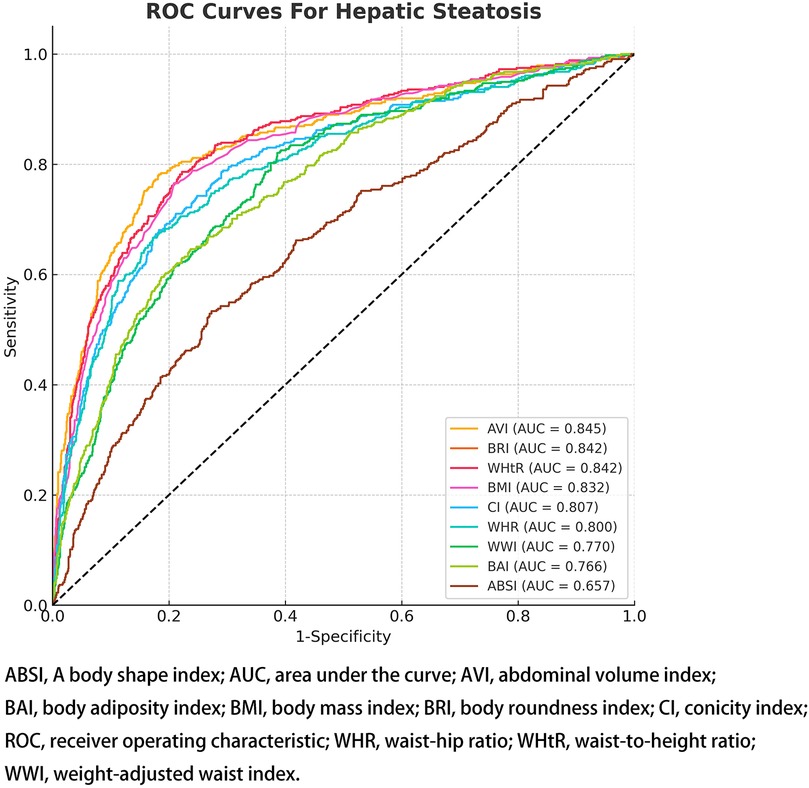
Figure 4. ROC curves representing anthropometric indices used for differentiating hepatic steatosis.
3.4 Subgroup analysis
Given the superior predictive accuracy of AVI among the indices, a subgroup analysis was conducted to explore how the association between AVI and hepatic steatosis varied across different demographic groups. The analysis revealed a consistent positive correlation between AVI and hepatic steatosis across all subgroups. Interaction tests indicated that race significantly influenced the relationship between AVI and hepatic steatosis (P for interaction < 0.05). Specifically, adolescents from multi-racial and other racial backgrounds exhibited a stronger association between AVI and hepatic steatosis than Mexican Americans, other Hispanics, non-Hispanic Whites, and non-Hispanic Blacks. However, age, sex, PIR, and smoking status did not significantly alter this relationship (P for interaction > 0.05; Table 4).
3.5 Predictive program design
A Python-based tool was developed to assist in calculating anthropometric indices associated with hepatic steatosis in adolescents. The program uses measurements such as height, weight, waist circumference, and hip circumference to compute AVI. It compares the calculated AVI to a threshold value of 14.9992, previously identified as optimal for predicting hepatic steatosis risk. If AVI meets or exceeds this threshold, the tool alerts the user to a potentially elevated risk of hepatic steatosis, recommending a consultation with a healthcare professional. Conversely, if AVI is below the threshold, the user is informed that their risk is not immediately significant, although maintaining a healthy lifestyle is still encouraged (Supplementary Material).
4 Discussion
This study, one of the first of its kind, investigated the relationship between hepatic steatosis and a range of anthropometric indices in a cohort of American adolescents, providing valuable insights into the broader demographic. Utilizing pre-pandemic NHANES data from 2017 to March 2020, we examined how nine different anthropometric indices correlate with hepatic steatosis in this age group. Our findings show that, after accounting for various factors, there is a positive association between these indices and hepatic steatosis. Notably, AVI displayed the strongest discriminative power for detecting hepatic steatosis in adolescents, with an AUC of 0.8454 (95% CI: 0.8221–0.8687), indicating excellent sensitivity and specificity. In addition, indices such as BRI, WHtR, BMI, CI, and WHR also exhibited elevated AUC values, suggesting their potential utility in the preliminary identification of hepatic steatosis among adolescents.
The complex relationship between obesity and hepatic steatosis has garnered significant scientific attention. Obesity-induced insulin resistance plays a pivotal role in the development of hepatic steatosis by triggering lipolysis in adipose cells, which releases free fatty acids (FFAs) into the bloodstream. These FFAs are then taken up by the liver, where they are converted into triglycerides, disrupting lipid metabolism and leading to hepatic fat accumulation (21). Additionally, obesity promotes chronic inflammation, with adipose tissue acting as a source of pro-inflammatory cytokines such as TNF-α, IL-6, and IL-1β, which exacerbate lipid deposition in the liver (22). The elevated fatty acid levels in the liver can induce oxidative stress and mitochondrial dysfunction, further damaging hepatocytes and accelerating the progression of steatosis (23). Recent studies have highlighted the role of impaired hepatic fatty acid oxidation (FAO) and mitochondrial turnover in the severity of NAFLD in obese individuals (24). Moreover, gut microbiome imbalances, or dysbiosis, may contribute to the worsening of obesity-related hepatic steatosis by affecting energy metabolism and inflammatory responses (25, 26). Research by Sergio et al. has shown that histidine supplementation can reduce Proteobacteria abundance in NAFLD models, improving hepatic steatosis, inflammation, and insulin resistance (27). Genetic and epigenetic factors also influence liver lipid metabolism, increasing the risk of steatosis. These interconnected mechanisms help explain the rising prevalence of hepatic steatosis in obese adolescents, which, if left untreated, may progress to non-alcoholic steatohepatitis, liver fibrosis, and, in severe cases, cirrhosis or liver cancer.
Anthropometric indices are critical tools for assessing obesity and its associated health risks. While the widely used BMI is a general indicator of obesity, it is limited in its ability to predict metabolic risks linked to visceral fat. This is because BMI does not distinguish between adipose and muscular tissues, nor does it account for fat distribution patterns (28–30). In contrast, indices such as AVI and BRI are more accurate representations of abdominal and visceral fat accumulation (31, 32) and are more strongly correlated with obesity-related diseases, including cardiovascular disease, diabetes, and NAFLD.
Hepatic steatosis is closely associated with several metabolic disorders, including insulin resistance, lipid metabolism dysfunction, and chronic inflammation (33–35). The accumulation of visceral fat plays a significant role in the development of hepatic steatosis in adolescents, and anthropometric indices serve as indirect measures of the risk for liver fat accumulation. In our study, nearly all the anthropometric measures demonstrated a positive correlation with hepatic steatosis, highlighting their utility as predictive tools. However, AVI stood out as the most accurate predictor, reflecting its higher sensitivity in detecting increases in visceral fat.
AVI, as a specific marker for abdominal fat accumulation, provides a more precise assessment of the relationship between visceral fat and metabolic diseases (36). Our results indicate that AVI has a stronger association with hepatic steatosis than other anthropometric indices, likely because it more effectively reflects visceral fat accumulation, making it a superior predictor of hepatic steatosis risk. Recent studies in adolescents have also shown that cardiovascular risk indices are closely related not only to hepatic steatosis but also to hyperinsulinemia and insulin resistance (37). Insulin resistance promotes lipolysis in adipose tissue, increasing the transport of FFAs to the liver, which in turn enhances hepatic triglyceride synthesis and accumulation. Moreover, chronic low-grade inflammation and oxidative stress may jointly contribute to both insulin resistance and hepatic steatosis, with visceral fat accumulation (as reflected by AVI and similar indices) serving as a central factor in this process. Furthermore, even when accounting for factors such as sex, age, and ethnicity, AVI continued to show a significant correlation with hepatic steatosis, reinforcing its potential as an independent predictor.
Our subgroup analysis revealed notable racial differences in the relationship between AVI and hepatic steatosis. Specifically, the association between AVI and hepatic steatosis was stronger in adolescents of other races, including multi-racial individuals, than in Mexican Americans, other Hispanics, non-Hispanic Whites, and non-Hispanic Blacks. These disparities may be due to variations in genetics, lifestyle, and environmental factors affecting liver fat metabolism, and suggest that future research should investigate the mechanisms underlying these racial differences. While factors such as age, sex, PIR, and smoking status did not significantly alter the association between AVI and hepatic steatosis, these findings emphasize the need for personalized approaches in managing liver health.
The clinical implications of this study are significant. First, AVI, as a convenient and non-invasive measure, can be used for early screening of liver health in adolescents, particularly in primary care settings with limited resources. This would allow for timely intervention in high-risk populations. Second, as AVI gains wider clinical adoption, future research should focus on refining its threshold values to enhance its applicability across different racial and demographic groups. Longitudinal studies are also needed to assess AVI's predictive value over time in the progression of hepatic steatosis and to explore its potential in combination with other biomarkers to develop a more comprehensive system for liver health assessment.
Despite providing strong support for the use of anthropometric indices, particularly AVI, as screening tools for hepatic steatosis in adolescents, this study has several limitations. First, our assessment of hepatic steatosis relied on FibroScan® CAP values, which, although widely used in clinical practice, have some limitations in accuracy when compared to liver biopsy (38). Second, while the NHANES dataset includes a racially diverse adolescent population from the US, the generalizability of these findings to other geographic regions or ethnic groups requires further investigation. It is also important to note that our study population was limited to adolescents aged 12–19 years, and thus the results may not be directly applicable to other age groups. In addition, due to limitations in the available data, we were unable to include several important factors that may contribute to hepatic steatosis, such as alcohol consumption, drug-induced liver injury (e.g., acetaminophen-related steatosis) (39), and certain underlying conditions such as celiac disease (40). Finally, as this is a cross-sectional study, causal relationships between anthropometric indices and hepatic steatosis cannot be established. Longitudinal studies are needed to further validate the long-term diagnostic utility of AVI.
5 Conclusion
In conclusion, AVI demonstrates considerable diagnostic potential for predicting hepatic steatosis in adolescents, providing valuable evidence to support its use in early screening and prevention. With the global rise in adolescent obesity, AVI—being a simple and effective anthropometric index—holds significant promise for broader application. Its ease of measurement makes it particularly suitable for implementation not only in primary care settings but also in school-based health programs.
Schools can incorporate AVI assessments into routine physical examinations to establish student health profiles and offer basic, personalized health advice. For students with abnormal AVI values, school physicians can conduct regular follow-ups to monitor the effectiveness of lifestyle interventions, such as increased physical activity and dietary modifications. In more serious cases, schools may notify parents and assist with referrals to specialized outpatient clinics at higher-level medical institutions (e.g., pediatric endocrinology) for further evaluation.
Meanwhile, parents can independently monitor their child's AVI at home using simple measurement tools or the program developed in this study, which is based on the AVI algorithm. This enables timely and user-friendly risk assessment, facilitating early detection and encouraging prompt medical consultation when necessary.
Together, these efforts contribute to a multi-tiered screening and management framework—from home and school monitoring to primary care and advanced clinical referral—thereby enhancing the translational value of AVI in real-world settings. This comprehensive approach not only supports early identification and intervention for hepatic steatosis in adolescents but also promotes greater public awareness and engagement in metabolic health.
Data availability statement
The datasets presented in this study can be found in online repositories. The names of the repository/repositories and accession number(s) can be found below: The data supporting the study's findings is readily available through the NHANES platform.
Ethics statement
The studies involving humans were approved by the NCHS Research Ethics Review Board. The studies were conducted in accordance with the local legislation and institutional requirements. Written informed consent for participation in this study was provided by the participants' legal guardians/next of kin.
Author contributions
RC: Conceptualization, Formal analysis, Methodology, Software, Writing – original draft. FZ: Data curation, Writing – original draft. JZ: Data curation, Writing – original draft. HT: Formal analysis, Writing – review & editing. BL: Conceptualization, Methodology, Writing – review & editing.
Funding
The author(s) declare that no financial support was received for the research and/or publication of this article.
Acknowledgments
The researchers extend their heartfelt gratitude to the contributors and team members of NHANES, spanning from 2017 to 2020.3, for their invaluable efforts and engagement.
Conflict of interest
The authors declare that the research was conducted in the absence of any commercial or financial relationships that could be construed as a potential conflict of interest.
Generative AI statement
The author(s) declare that no Generative AI was used in the creation of this manuscript.
Publisher's note
All claims expressed in this article are solely those of the authors and do not necessarily represent those of their affiliated organizations, or those of the publisher, the editors and the reviewers. Any product that may be evaluated in this article, or claim that may be made by its manufacturer, is not guaranteed or endorsed by the publisher.
Supplementary material
The Supplementary Material for this article can be found online at: https://www.frontiersin.org/articles/10.3389/fped.2025.1558023/full#supplementary-material
References
1. Ogden CL, Fryar CD, Martin CB, Freedman DS, Carroll MD, Gu Q, et al. Trends in obesity prevalence by race and hispanic origin-1999–2000 to 2017–2018. JAMA. (2020) 324(12):1208–10. doi: 10.1001/jama.2020.14590
2. Rao WW, Zong QQ, Zhang JW, An FR, Jackson T, Ungvari GS, et al. Obesity increases the risk of depression in children and adolescents: results from a systematic review and meta-analysis. J Affect Disord. (2020) 267:78–85. doi: 10.1016/j.jad.2020.01.154
3. Geva N, Pinhas-Hamiel O, Frenkel H, Shina A, Derazne E, Tzur D, et al. Obesity and sleep disorders: a nationwide study of 1.3 million Israeli adolescents. Obes Res Clin Pract. (2020) 14(6):542–7. doi: 10.1016/j.orcp.2020.10.008
4. Liu G, Guo J, Zhang X, Lu Y, Miao J, Xue H. Obesity is a risk factor for central precocious puberty: a case-control study. BMC Pediatr. (2021) 21(1):509. doi: 10.1186/s12887-021-02936-1
5. Jeong SI, Kim SH. Obesity and hypertension in children and adolescents. Clin Hypertens. (2024) 30(1):23. doi: 10.1186/s40885-024-00278-5
6. Shaunak M, Byrne CD, Davis N, Afolabi P, Faust SN, Davies JH. Non-alcoholic fatty liver disease and childhood obesity. Arch Dis Child. (2021) 106(1):3–8. doi: 10.1136/archdischild-2019-318063
7. Anderson EL, Howe LD, Jones HE, Higgins JP, Lawlor DA, Fraser A. The prevalence of non-alcoholic fatty liver disease in children and adolescents: a systematic review and meta-analysis. PLoS One. (2015) 10(10):e0140908. doi: 10.1371/journal.pone.0140908
8. DeBoer MD. Assessing and managing the metabolic syndrome in children and adolescents. Nutrients. (2019) 11(8):1788. doi: 10.3390/nu11081788
9. Perumpail BJ, Khan MA, Yoo ER, Cholankeril G, Kim D, Ahmed A. Clinical epidemiology and disease burden of nonalcoholic fatty liver disease. World J Gastroenterol. (2017) 23(47):8263–76. doi: 10.3748/wjg.v23.i47.8263
10. Powell EE, Wong VW, Rinella M. Non-alcoholic fatty liver disease. Lancet. (2021) 397(10290):2212–24. doi: 10.1016/s0140-6736(20)32511-3
11. Fraum TJ, Ludwig DR, Kilian S, Curtis WA, Pilgram TK, Sirlin CB, et al. Epidemiology of hepatic steatosis at a tertiary care center: an mri-based analysis. Acad Radiol. (2018) 25(3):317–27. doi: 10.1016/j.acra.2017.10.002
12. Shen Y, Wu Y, Fu M, Zhu K, Wang J. Association between weight-adjusted-waist index with hepatic steatosis and liver fibrosis: a nationally representative cross-sectional study from nhanes 2017 to 2020. Front Endocrinol (Lausanne). (2023) 14:1159055. doi: 10.3389/fendo.2023.1159055
13. Sheng G, Xie Q, Wang R, Hu C, Zhong M, Zou Y. Waist-to-height ratio and non-alcoholic fatty liver disease in adults. BMC Gastroenterol. (2021) 21(1):239. doi: 10.1186/s12876-021-01824-3
14. Di H, Guo Y, Daghlas I, Wang L, Liu G, Pan A, et al. Evaluation of sleep habits and disturbances among US adults, 2017–2020. JAMA Netw Open. (2022) 5(11):e2240788. doi: 10.1001/jamanetworkopen.2022.40788
15. Wu LD, Kong CH, Shi Y, Zhang JX, Chen SL. Associations between novel anthropometric measures and the prevalence of hypertension among 45,853 adults: a cross-sectional study. Front Cardiovasc Med. (2022) 9:1050654. doi: 10.3389/fcvm.2022.1050654
16. Zhang J, Liang D, Xu L, Liu Y, Jiang S, Han X, et al. Associations between novel anthropometric indices and the prevalence of gallstones among 6,848 adults: a cross-sectional study. Front Nutr. (2024) 11:1428488. doi: 10.3389/fnut.2024.1428488
17. Bergman RN, Stefanovski D, Buchanan TA, Sumner AE, Reynolds JC, Sebring NG, et al. A better index of body adiposity. Obesity (Silver Spring, Md). (2011) 19(5):1083–9. doi: 10.1038/oby.2011.38
18. Liu Y, Chai S, Zhang X. Association between different parameters of adipose distribution and transient elastography-assessed hepatic steatosis in American adults with diabetes, prediabetes and normal glucose tolerance. Diabetes Metab Syndr Obes. (2023) 16:299–308. doi: 10.2147/dmso.S394564
19. Sirli R, Sporea I. Controlled attenuation parameter for quantification of steatosis: which cut-offs to use? Can J Gastroenterol Hepatol. (2021) 2021:6662760. doi: 10.1155/2021/6662760
20. She D, Jiang S, Yuan S. Association between serum cotinine and hepatic steatosis and liver fibrosis in adolescent: a population-based study in the United States. Sci Rep. (2024) 14(1):11424. doi: 10.1038/s41598-024-61771-3
21. Khan RS, Bril F, Cusi K, Newsome PN. Modulation of insulin resistance in nonalcoholic fatty liver disease. Hepatology. (2019) 70(2):711–24. doi: 10.1002/hep.30429
22. Wang X, He Q, Zhou C, Xu Y, Liu D, Fujiwara N, et al. Prolonged hypernutrition impairs trem2-dependent efferocytosis to license chronic liver inflammation and nash development. Immunity. (2023) 56(1):58–77.e11. doi: 10.1016/j.immuni.2022.11.013
23. García-Ruiz C, Baulies A, Mari M, García-Rovés PM, Fernandez-Checa JC. Mitochondrial dysfunction in non-alcoholic fatty liver disease and insulin resistance: cause or consequence? Free Radical Res. (2013) 47(11):854–68. doi: 10.3109/10715762.2013.830717
24. Moore MP, Cunningham RP, Meers GM, Johnson SA, Wheeler AA, Ganga RR, et al. Compromised hepatic mitochondrial fatty acid oxidation and reduced markers of mitochondrial turnover in human nafld. Hepatology. (2022) 76(5):1452–65. doi: 10.1002/hep.32324
25. Aron-Wisnewsky J, Vigliotti C, Witjes J, Le P, Holleboom AG, Verheij J, et al. Gut microbiota and human nafld: disentangling microbial signatures from metabolic disorders. Nat Rev Gastroenterol Hepatol. (2020) 17(5):279–97. doi: 10.1038/s41575-020-0269-9
26. Yang YJ, Ni YH. Gut microbiota and pediatric obesity/non-alcoholic fatty liver disease. J Formos Med Assoc. (2019) 118(Suppl 1):S55–61. doi: 10.1016/j.jfma.2018.11.006
27. Quesada-Vázquez S, Castells-Nobau A, Latorre J, Oliveras-Cañellas N, Puig-Parnau I, Tejera N, et al. Potential therapeutic implications of histidine catabolism by the gut microbiota in nafld patients with morbid obesity. Cell Rep Med. (2023) 4(12):101341. doi: 10.1016/j.xcrm.2023.101341
28. Frankenfield DC, Rowe WA, Cooney RN, Smith JS, Becker D. Limits of body mass index to detect obesity and predict body composition. Nutrition. (2001) 17(1):26–30. doi: 10.1016/s0899-9007(00)00471-8
29. Grier T, Canham-Chervak M, Sharp M, Jones BH. Does body mass index misclassify physically active young men. Prev Med Rep. (2015) 2:483–7. doi: 10.1016/j.pmedr.2015.06.003
30. van der Kolk BW, Saari S, Lovric A, Arif M, Alvarez M, Ko A, et al. Molecular pathways behind acquired obesity: adipose tissue and skeletal muscle multiomics in monozygotic twin pairs discordant for bmi. Cell Rep Med. (2021) 2(4):100226. doi: 10.1016/j.xcrm.2021.100226
31. Hu X, Appleton AA, Ou Y, Zhang Y, Cai A, Zhou Y, et al. Abdominal volume index trajectories and risk of diabetes mellitus: results from the China health and nutrition survey. J Diabetes Investig. (2022) 13(5):868–77. doi: 10.1111/jdi.13733
32. Thomas DM, Bredlau C, Bosy-Westphal A, Mueller M, Shen W, Gallagher D, et al. Relationships between body roundness with body fat and visceral adipose tissue emerging from a new geometrical model. Obesity (Silver Spring, Md). (2013) 21(11):2264–71. doi: 10.1002/oby.20408
33. Semmler G, Balcar L, Wernly S, Völkerer A, Semmler L, Hauptmann L, et al. Insulin resistance and central obesity determine hepatic steatosis and explain cardiovascular risk in steatotic liver disease. Front Endocrinol (Lausanne). (2023) 14:1244405. doi: 10.3389/fendo.2023.1244405
34. Heeren J, Scheja L. Metabolic-associated fatty liver disease and lipoprotein metabolism. Mol Metab. (2021) 50:101238. doi: 10.1016/j.molmet.2021.101238
35. Tarantino G, Savastano S, Colao A. Hepatic steatosis, low-grade chronic inflammation and hormone/growth factor/adipokine imbalance. World J Gastroenterol. (2010) 16(38):4773–83. doi: 10.3748/wjg.v16.i38.4773
36. Perona JS, Schmidt Rio-Valle J, Ramírez-Vélez R, Correa-Rodríguez M, Fernández-Aparicio Á, González-Jiménez E. Waist circumference and abdominal volume index are the strongest anthropometric discriminators of metabolic syndrome in Spanish adolescents. Eur J Clin Investig. (2019) 49(3):e13060. doi: 10.1111/eci.13060
37. Sodero G, Rigante D, Pane LC, Sessa L, Quarta L, Candelli M, et al. Cardiometabolic risk assessment in a cohort of children and adolescents diagnosed with hyperinsulinemia. Diseases. (2024) 12(6):119. doi: 10.3390/diseases12060119
38. Stern C, Castera L. Non-invasive diagnosis of hepatic steatosis. Hepatol Int. (2017) 11(1):70–8. doi: 10.1007/s12072-016-9772-z
39. García-Román R, Francés R. Acetaminophen-induced liver damage in hepatic steatosis. Clin Pharmacol Ther. (2020) 107(5):1068–81. doi: 10.1002/cpt.1701
Keywords: anthropometric indices, AVI, hepatic steatosis, adolescent, NHANES
Citation: Chen R, Zhou F, Zhang J, Tong H and Lu B (2025) Nine anthropometric indices predict hepatic steatosis and assess liver health in adolescents: a population-based study. Front. Pediatr. 13:1558023. doi: 10.3389/fped.2025.1558023
Received: 9 January 2025; Accepted: 26 May 2025;
Published: 9 June 2025.
Edited by:
Johanna K. Distefano, Translational Genomics Research Institute (TGen), United StatesReviewed by:
Rubaiyat Alam, Bangabandhu Sheikh Mujib Medical University (BSMMU), BangladeshPenelope Rose, Stellenbosch University, South Africa
Godfrey Katamba, Mbarara University of Science and Technology, Uganda
Giorgio Sodero, Azienda Sanitaria Locale di Brindisi, Italy
Copyright: © 2025 Chen, Zhou, Zhang, Tong and Lu. This is an open-access article distributed under the terms of the Creative Commons Attribution License (CC BY). The use, distribution or reproduction in other forums is permitted, provided the original author(s) and the copyright owner(s) are credited and that the original publication in this journal is cited, in accordance with accepted academic practice. No use, distribution or reproduction is permitted which does not comply with these terms.
*Correspondence: Baochun Lu, bHViYW9jaHVuQHpqdS5lZHUuY24=
 Ruanchang Chen
Ruanchang Chen Fangzheng Zhou1,2
Fangzheng Zhou1,2 Jiayao Zhang
Jiayao Zhang Baochun Lu
Baochun Lu